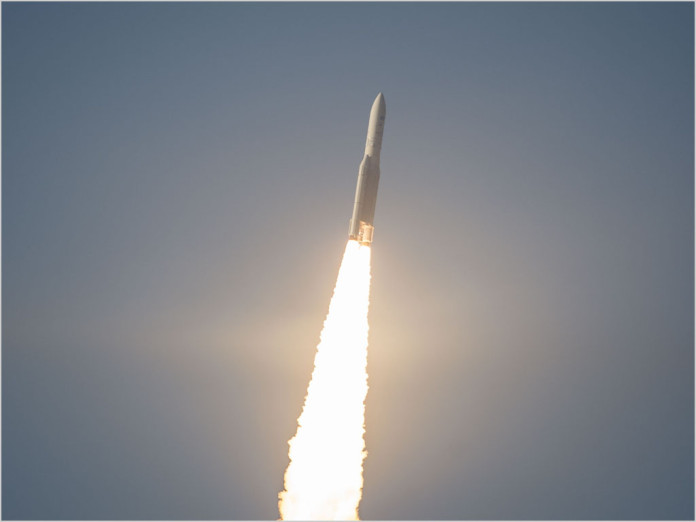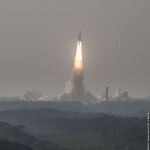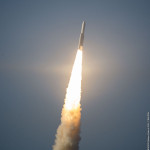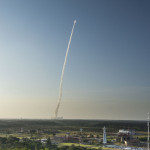
This morning, something remarkable happened.
From an isolated location close to the coast in the small South American country of French Guiana, a few Australians, with support from many people from other countries, successfully blasted a rocket weighing some 750 tonnes into orbit around the Earth, carrying a payload of some 6.5 tonnes.
Once in space, the payload will find its correct position and then unfurl, leaving a piece of incredibly complicated electronic infrastructure sitting permanently in the skies above Australia.
The launch was an incredibly explosive event, with many tonnes of fuel creating a huge blast which hurtled the rocket and its payload from the ground. This amount of noise and power feels appropriate to the herculean task which resulted in the energy released this morning.
Along the way to this journey, there were people who said that this could not be done — that the engineers behind this project had not properly obtained the correct orbital positions for this hunk of metal and silicon.
But that was not true. The engineers had.
There were also people who said that there was no need to send a new rocket hurtling into space to deliver this piece of infrastructure to sit in the heavens so far above the Australians who crawl on the Earth underneath it. They said existing satellites could provide sufficient capacity.
But that was also not true. The engineers were right. Existing satellites were not enough.
There were people who pointed out the risks of this launch. The rocket could explode before it even got off the ground, they said. Or it could explode in mid-air. Something could go catastrophically wrong, costing Australia hundreds of millions of dollars.
But it didn’t. The engineers had set up the rocket correctly.
The Australian engineers who put this plan together were not part of a huge, well-established company with decades of experience launching satellites into orbit around the Earth. They did not have the luxury of knowing that they could get things wrong and try again.
They were not involved in this effort for money, career advancement or personal glory. There is no doubt that some of them took pay cuts or gave up other opportunities to come to the team that launched this satellite this morning. They knew that they would be working extremely hard — around the clock at times — without the backing of a large company, and that they would be creating much of this project from scratch, without the benefit of established procedures.
They knew that if this project was to succeed — if they were to be able to launch a modern communications satellite into orbit to serve Australia’s rural broadband needs for much of the next century — that the effort would succeed or fail purely on the strength of their knowledge and skills. It would be their personal mental effort — their thinking — that would get this satellite built and launched into the sky.
If the rocket blew up on the pad or in mid-air, or if the satellite did not work, it would be because they had made a mistake in their calculations. The project lived or died on their engineering skill alone.
And yet they came to join the NBN company to build satellites. They believed in its vision. They came to serve the public. They knew that a job needed to be done, so they stepped up. They put their names forward and shouldered the responsibility.
Along the way they have endured much. They have sat silent as politicians ridiculed them and their effort. They have answered a thousand incessant questions about the NBN satellite project from people who have no engineering background. They have spend six years doing rigorous planning, considering in exhaustive detail all of the things that could go wrong.
They have watched as the political fortunes of the NBN project have waxed and waned, as their work has been attacked again and again. They have watched as the leaders of their company were shown the door as the politicians changed positions in Canberra. I am sure that many engineers at the NBN company have woken up on many mornings and considered leaving. Some have.
And yet they did endure.
This morning, a bunch of NBN company engineers watched as a 750 tonne rocket delivered a 6.5 tonne payload into orbit over Australia.
Their efforts succeeded. Their calculations were correct. Nothing went wrong.
The end result will be remarkable. Those years of effort will translate into an incredible upgrade of broadband infrastructure to rural and remote Australia. All around this fair land, Australians of all backgrounds will have their broadband speeds massively upgraded. The benefits of this morning’s launch will be felt for many decades. This launch will create a huge impact.
It will unlock educational opportunities for Australians living in the bush. It will unlock health opportunities. Business opportunities. And of course, opportunities to communicate with family and friends. It will severely cut down that horrible tyranny of distance that those Australians who live in the bush know so well, and curse so often.
The politicians are already celebrating this victory. It is their faces that will be on television today, with incredible video footage of a high-powered rocket reaching for the skies in the background. It is their voices that will be telling Australia the news of the successful launch. They will continue to take credit for everything that has gone right today and will continue to go right in future.
But this article is not for them.
This article is for all the engineers who made this project possible.
You faced an incredibly difficult task, in very difficult circumstances. You had to defeat a thousand obstacles to make this morning’s NBN satellite launch happen.
And yet, you prevailed. Your minds were strong. Your calculations were correct. Your relationships with your partner companies held up. You chose your equipment wisely. You researched thoroughly. You did your job. And you did a good job. (And, of course, for Satellite #2, you will do it all over again.)
Nobody knows better than an engineer that a good job is truly its own satisfaction.
But, for what it’s worth, I also say to you now: Thank you. Thank you, very much. From every Australian who currently has poor broadband, thank you. From everyone who has ever had their access to the Internet limited, thank you. And from the children of the future, thank you.
From this day on, whenever Australian engineers are facing a tough task, they should look up into the skies and remind themselves of the power of the Australian mind. If Australian ingenuity can put such a hunk of incredibly complex communications infrastructure into orbit to serve our broadband needs, purely on the strength of some clear thinking and a lot of hard work, then we truly can do anything.
And we will.
Image credit: Provided by NBN Co







*clap clap*
About time the engineers get some credit :)
Like in the building industry, people always credit the architects… The things wouldn’t be standing if it wasn’t for the engineers!
Good read :)
Well said…hope Mike Quigley reads this….
Thanks for showing up “The Politician” who opposed it the loudest…..Yes our PM MT….
Regards
Alfred
Well said! Great article!
It appears that PM Turnbull’s blog post is no longer there.
Or should I say, it never existed.
We have always been at war with Eurasia….
Edit: Bitterness aside, this is a wonderful day for Engineers and Australia both.
Google cache doesn’t lie….
http://webcache.googleusercontent.com/search?q=cache:Axx7X_zO-wcJ:www.malcolmturnbull.com.au/media/nbn-contracts-to-buy-two-satellites-without-the-orbital-slots-to-fly-them-i+&cd=1&hl=en&ct=clnk&gl=au
Most people would not look that closely, until you try to hide it.
/tips hat at Turnbull’s media machine
Well done :P
Looks like it still exists on the blog too, just a different URL to the one Renai linked:
http://www.malcolmturnbull.com.au/media/nbn-contracts-to-buy-two-satellites-without-the-orbital-slots-to-fly-them-i
They still need to make positive contact with skymuster.
What can happen is a successful launch. But something goes wrong and the satellite doesn’t response in space, Like sending your parents a router in the post and somehow it doesnt connect at the other end
No worries — just send Mark Watney up to take a look at it. What could go wrong?
Normally what happens is a command is send to satellite to check its health, fire some positioning rockets and maybe slow the craft down after orbit and changes it orbit projectory of the craft
Its interesting watching the new comms minister. I think you Renai asked the question or someone asked about “What happens now if we can’t make positive contact?” and first word they said was “we have insurance”
https://en.wikipedia.org/wiki/Satellite_insurance
Sadly the NBN company decided not to invite me to the press conference because I don’t live in Sydney. I have had stern words with them about this.
It’s a poor showing that the NBN feels they can snub an internationaly famous media organisation like this! ! In fact, it’s an outrage!!
The best part is that the Coalition sensibly reworked the satellite to make use of existing infrastructure. All you have to do is point your old analogue TV antenna upwards and you can connect to the world using the latest teletext technology.
Can I send a fax from the satellite? :)
Only on stone tablet…
Over voip. Yes
The irony is not lost on anyone that the same people who said:
“There were also people who said that there was no need to send a new rocket hurtling into space to deliver this piece of infrastructure to sit in the heavens so far above the Australians who crawl on the Earth underneath it. They said existing satellites could provide sufficient capacity.:
Are also the same people who said:
The politicians are already celebrating this victory. It is their faces that will be on television today, with incredible video footage of a high-powered rocket reaching for the skies in the background. It is their voices that will be telling Australia the news of the successful launch. They will continue to take credit for everything that has gone right today and will continue to go right in future.
Buggers.
But, serious question, how come it will take up to 6 months to commission it. What are the processes involved?
@BruceH: it takes a few days to a few weeks to get into the orbital slot (can be done faster using more fuel, or slower using less), and then there’s a long, slow process of checking and testing. Firstly there’s the systems that keep the satellite running: telemetry, tracking and command systems, the power systems, thermal control, control, propulsion, etc. Then they move on to the comms payload, making sure everything is on spec.
This all gets checked on the ground, but launch is very violent and the operating environment is extremely harsh, so lots can happen along the way. They need to know the performance characteristics precisely so that they can provide the required service levels without messing with other operators
The Ariane 5 gives a very rough ride too, there’s more severe vibration on the way up than on most boosters. About its only disadvantage, it’s a good bit of kit.
Good job, and well done!
Congrats to a job well done!
A great achievement, something all engineers involved should be immensely proud of.
This article has convinced me to become a member.
Nice work NBN! and nice work Renai on such a positive article.
Awesome, cheers — much appreciated!
Legends. Every person who worked on launching that satellite. Whether your name is ever known to the public or not. Whether you did calculations, handled the rocket fuel [ hopefully in protective gear because it’s toxic, nasty stuff], planned the launch, or did anything else, you are what this country is meant to be about: hard work, pride in what you do and not giving up.
Renai, just out of interest and you would know this better than us, do people who work on these projects get a letter of thanks from the PM or the relevant minister?
“Renai, just out of interest and you would know this better than us, do people who work on these projects get a letter of thanks from the PM or the relevant minister?”
Hmm not sure. I’ll ask if I get the chance.
Most of the credit for the booster has to go to ESA – the engineers of the European Space Agency. However, the integration of booster with payload is not just an essential, but a major task, involving a team of Australian and ESA engineers, working *as* a team. In many ways, that’s harder than a single, coherent group working on it, and requires supreme standards of professionalism by all concerned.
Yes, you have to do everything right. The smallest fault anywhere is very likely to lead to disaster. We’re still on the raw, bleeding edge of technology here, and it has to be said, margins are necessarily so tight that even when you do absolutely everything right, unforeseen and unforeseeable events can make everything turn pear-shaped. Even the very best boosters only have a 95% success rate. So complete, total competence is necessary, but not sufficient. You need a smidgen of luck too.
Plenty can still go wrong, by the way. The Japanese greyhound bus-sized bird ADEOS-II launched successfully, turned on successfully, but after 6 months the power failed. The Australian FEDSAT satellite, still the most complex and capable microsat ever launched, was on the same booster as ADEOS-II, but separation caused a tumble that only genius, perseverance, and planning by an all-Australian ground crew managed to stabilise. That, and a “smidgen of luck” again.
Congrats to all concerned. After power-up, turn-on, and boost to geosync orbit, you can stop gnawing your knuckles, guys. Nearly there.
https://www.youtube.com/watch?v=LjWIN61dpOQ
The video shows booster separation of the Japanese H2A at 12:15:40, the Japanese ADEOS-2 at 12:16:20, the Australian FedSat at 12:16:40, the Japanese MicroLabSat at 12:17:00 and WEOS at 12:17:20
Australia is the only country which has had a successful space program – and abandoned it. We’ve done it twice.
WRESAT (Weapons Research Establishment Satellite) was the first Australian satellite, launched in 1967 from Woomera. The launch made Australia the seventh nation to launch an Earth satellite and the fourth nation to launch one from its own territory. But a political decision to concentrate on primary industry rather than technology terminated all satellite development in 1972.
25 years later, we started from scratch again, with FEDSAT, launched in 2002 from Tanegashima space centre in Japan. The integration task with the brand-new Japanese H2A booster was tricky, but both Australian engineers doing it all for the first time, and Japanese engineers with much experience, came through magnificently.
Despite – or because of – the satellite exceeding all expectations, scoring a number of space firsts, government funding terminated with the pious hope that Australian Industry would pick up the slack.
It didn’t happen. At one stage, we had a fully functional satellite, still giving useful scientific research results – and no money to operate a ground monitoring station. We were about to decommission it when the Dept of Defence stepped in – they had a use for the worldwide secure packet switching comms it provided as just one of the functions.
Australian engineers have demonstrated repeatedly over nearly 50 years that they’re as good as the very, very best when it comes to space development. Australian politicians…. the opposite.
Comments are closed.